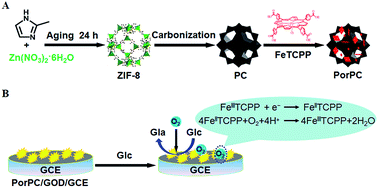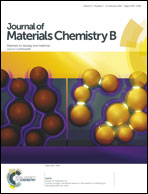Porphyrin functionalized porous carbon derived from metal–organic framework as a biomimetic catalyst for electrochemical biosensing
Abstract
In this work, a kind of biomimetic catalyst was designed as a signal probe by the assembly of porphyrin on porous carbon (PC) derived from metal–organic frameworks for electrochemical biosensing. First, PC was prepared by direct carbonization of a zeolite-type metal–organic framework as both a precursor and a template, and characterized by transmission electron microscopy, nitrogen sorption isotherm, X-ray photoelectron spectroscopy and X-ray diffraction. Then the PC was non-covalently functionalized with iron(III) meso-5,10,15,20-tetrakis(4-carboxyphenyl) porphyrin chloride (FeTCPP) via non-covalent interactions. The resulting nanocomposite of PC/FeTCPP possesses an excellent electrocatalytic activity toward oxygen reduction. Coupling with the enzymatic catalysis of glucose oxidase, a glucose biosensor was constructed on the basis of O2 consumption. The biomimetic sensor enables a reliable and sensitive determination of glucose with a linear range of 0.5 to 18 mM and a detection limit of 0.08 mM at a signal-to-noise ratio of 3. Moreover, the biosensor exhibits the analytical reproducibility and stability with a lower relative standard deviation of 4.2%. In an application to detect glucose in human serum samples, this glucose biosensor had good detection accuracy with analytical recoveries from 97.3% to 107.7%. Therefore, the porphyrin functionalized PC provides a promising biomimetic platform for constructing the biosensors, and has potential application in bioanalysis and clinical diagnosis.


 Please wait while we load your content...
Please wait while we load your content...